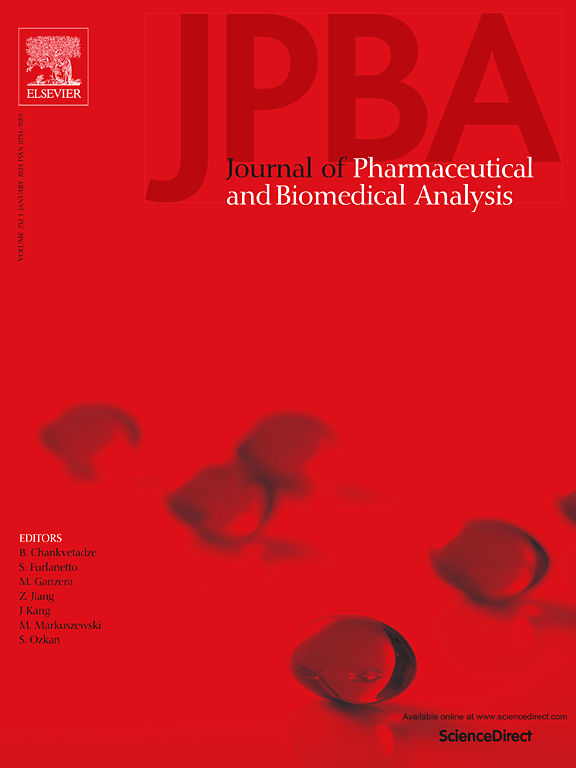Multiple oxidative modifications on hemoglobin are elevated in breast cancer patients as measured by nanoflow liquid chromatography-tandem mass spectrometry
IF 3.1
3区 医学
Q2 CHEMISTRY, ANALYTICAL
Journal of pharmaceutical and biomedical analysis
Pub Date : 2024-09-18
DOI:10.1016/j.jpba.2024.116477
引用次数: 0
Abstract
Breast cancer is strongly connected with elevated oxidative stress. Oxidative modifications of hemoglobin can serve as biomarkers for monitoring oxidative stress status in vivo. The structure of hemoglobin modifications derived from malondialdehyde (MDA) in human blood hemoglobin exists as N-propenal and dihydropyridine (DHP). This study reports the simultaneous quantification of eleven modified peptides in hemoglobin derived from MDA and advanced histidine oxidation in 16 breast cancer patients and 16 healthy women using nanoflow liquid chromatography nanoelectrospray ionization tandem mass spectrometry. The results reveal statistically significant increases in the formation of MDA-derived N-propenal and DHP of lysine and advanced oxidation of histidine in hemoglobin of breast cancer patients with the Mann-Whitney U-test p values < 0.0001 and the AUC of ROC between 0.9277 and 1.0. Furthermore, the elevation in modified peptides is significant in patients with early stages of breast cancer. By measuring these oxidative modifications in hemoglobin from a drop of blood, the role of lipid peroxidation and oxidative stress in breast cancer can be assessed using this sensitive assay.
纳米流液相色谱-串联质谱法测定乳腺癌患者血红蛋白的多种氧化修饰升高
乳腺癌与氧化应激升高密切相关。血红蛋白的氧化修饰可作为监测体内氧化应激状态的生物标志物。人体血液血红蛋白中的丙二醛(MDA)衍生出的血红蛋白修饰结构为 N-丙烯醛和二氢吡啶(DHP)。本研究采用纳米流液相色谱-纳米电喷雾离子化串联质谱法,同时定量检测了 16 名乳腺癌患者和 16 名健康女性血红蛋白中由 MDA 和高级组氨酸氧化产生的 11 种修饰肽。结果表明,乳腺癌患者血红蛋白中 MDA 衍生的 N-丙烯醛和赖氨酸的 DHP 以及组氨酸的高级氧化物的形成在统计学上有显著增加,曼-惠特尼 U 检验的 p 值为 < 0.0001,ROC 的 AUC 在 0.9277 和 1.0 之间。此外,乳腺癌早期患者的修饰肽含量明显升高。通过测量一滴血中血红蛋白的氧化修饰,这种灵敏的检测方法可以评估脂质过氧化和氧化应激在乳腺癌中的作用。
本文章由计算机程序翻译,如有差异,请以英文原文为准。
求助全文
约1分钟内获得全文
求助全文
来源期刊
CiteScore
6.70
自引率
5.90%
发文量
588
审稿时长
37 days
期刊介绍:
This journal is an international medium directed towards the needs of academic, clinical, government and industrial analysis by publishing original research reports and critical reviews on pharmaceutical and biomedical analysis. It covers the interdisciplinary aspects of analysis in the pharmaceutical, biomedical and clinical sciences, including developments in analytical methodology, instrumentation, computation and interpretation. Submissions on novel applications focusing on drug purity and stability studies, pharmacokinetics, therapeutic monitoring, metabolic profiling; drug-related aspects of analytical biochemistry and forensic toxicology; quality assurance in the pharmaceutical industry are also welcome.
Studies from areas of well established and poorly selective methods, such as UV-VIS spectrophotometry (including derivative and multi-wavelength measurements), basic electroanalytical (potentiometric, polarographic and voltammetric) methods, fluorimetry, flow-injection analysis, etc. are accepted for publication in exceptional cases only, if a unique and substantial advantage over presently known systems is demonstrated. The same applies to the assay of simple drug formulations by any kind of methods and the determination of drugs in biological samples based merely on spiked samples. Drug purity/stability studies should contain information on the structure elucidation of the impurities/degradants.

 求助内容:
求助内容: 应助结果提醒方式:
应助结果提醒方式:


